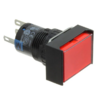Dang! Those are expensive! Are they so pricy because they are specifically made for industrial use?
Yep, those are expensive. I never had to use one. We had one piece of equipment that had 200A of either single phase or 3 phase coming into it. It used one.
My panel had a key lock, but I wasn't concerned about bypassing. The key stayed in the panel unless there was a reason to tag it out. It happened a few times for >1 month at a time.
I bought like 100 of these
https://www.digikey.com/en/products/detail/idec/AL6H-M14P-R/8344683
But from a different manuafacturer. They are like $25.00 each when your done. LED lamps, removeable different color lenses. You can label them under the lens. I had to replace nearly all of the other manufcturer's buttons/lamps because they changed to a new design where an O-ring held the button to the incadesent lamp and trapped the heat and the plastic got brittle. That was down right annoying.
Most were indicator only. The switches I used were rotary and 22mm style.
Idec had different color LEDs for each lens and were AC/DC
Industrial control panels are usually 24 VDC. I goofed and made mine 24 VAC. That was the first ones I did.
I basically built an alarm system with relay logic with one 3PDT relay per point. One contact was the NC alarm loop, one was the lighting circuit and the third was the latch. I didn't latch the panic buttons (local and exit doors). It probably was a good safety idea. No "alarm" was needed. The panel just had to quietly shut off some valves. No alarm history either.
I think the main mistake was not using "monitored contacts" which would have been a two wire system with an end of line resistor. A break in the line would have caused a trouble alarm.
The panel was upgraded once after it actually worked. el-cheap-o and "modified" air velocity sensors were upgraded and included a display. Hydrogen sensors that were not installed, were installed,. the gas involved in the "explosion" was hydrogen.
Then it got an expansion to enable another system. The other system got a PLC shutdown system with a UPS.












